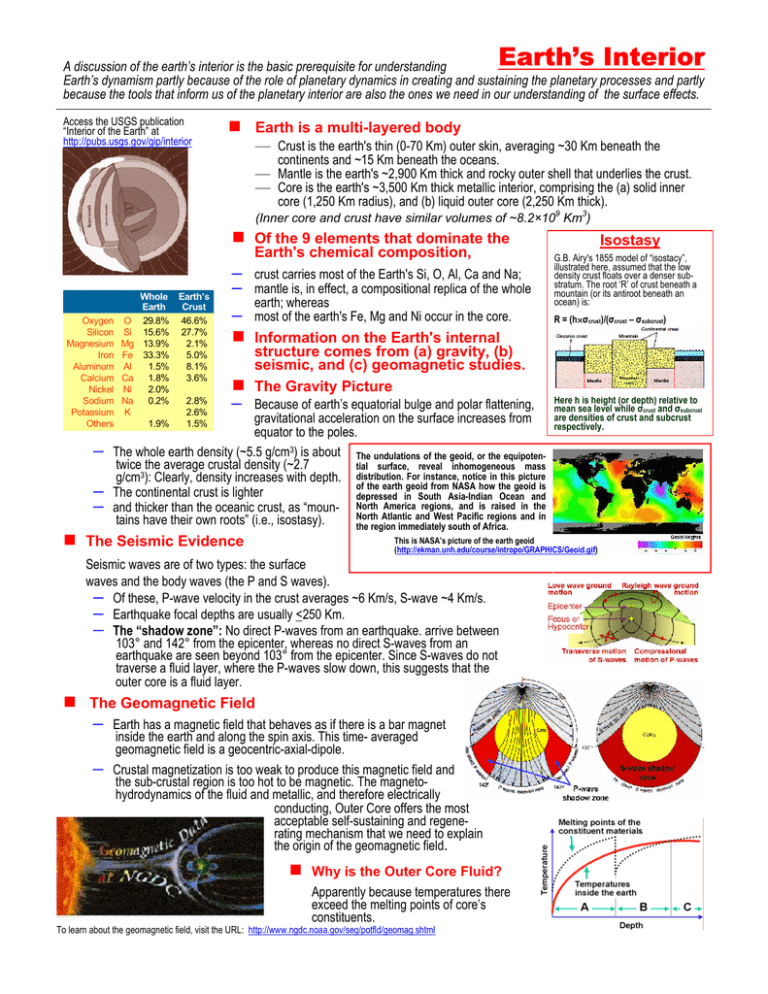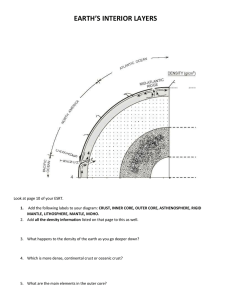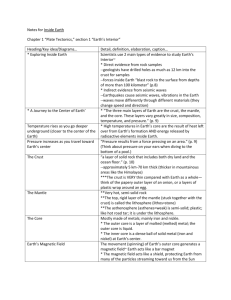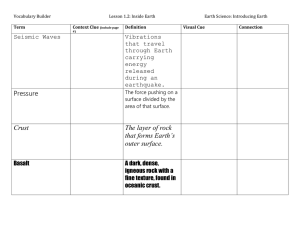Earth’s Interior
advertisement

Earth’s Interior A discussion of the earth’s interior is the basic prerequisite for understanding Earth’s dynamism partly because of the role of planetary dynamics in creating and sustaining the planetary processes and partly because the tools that inform us of the planetary interior are also the ones we need in our understanding of the surface effects. Access the USGS publication “Interior of the Earth” at http://pubs.usgs.gov/gip/interior Earth is a multi-layered body — Crust is the earth's thin (0-70 Km) outer skin, averaging ~30 Km beneath the continents and ~15 Km beneath the oceans. — Mantle is the earth's ~2,900 Km thick and rocky outer shell that underlies the crust. — Core is the earth's ~3,500 Km thick metallic interior, comprising the (a) solid inner core (1,250 Km radius), and (b) liquid outer core (2,250 Km thick). (Inner core and crust have similar volumes of ~8.2×109 Km3) Of the 9 elements that dominate the Earth's chemical composition, Oxygen Silicon Magnesium Iron Aluminum Calcium Nickel Sodium Potassium Others – – – O Si Mg Fe Al Ca Ni Na K Whole Earth’s Earth Crust 29.8% 46.6% 15.6% 27.7% 2.1% 13.9% 5.0% 33.3% 8.1% 1.5% 3.6% 1.8% 2.0% 2.8% 0.2% 2.6% 1.5% 1.9% – – – crust carries most of the Earth's Si, O, Al, Ca and Na; mantle is, in effect, a compositional replica of the whole earth; whereas most of the earth's Fe, Mg and Ni occur in the core. structure comes from (a) gravity, (b) seismic, and (c) geomagnetic studies. The Gravity Picture – Because of earth’s equatorial bulge and polar flattening, gravitational acceleration on the surface increases from equator to the poles. The whole earth density (~5.5 g/cm3) is about The undulations of the geoid, or the equipotentwice the average crustal density (~2.7 tial surface, reveal inhomogeneous mass g/cm3): Clearly, density increases with depth. distribution. For instance, notice in this picture of the earth geoid from NASA how the geoid is The continental crust is lighter depressed in South Asia-Indian Ocean and and thicker than the oceanic crust, as “moun- North America regions, and is raised in the North Atlantic and West Pacific regions and in tains have their own roots” (i.e., isostasy). the region immediately south of Africa. R = (h×σcrust)/(σcrust – σsubcrust) Here h is height (or depth) relative to mean sea level while σcrust and σsubcrust are densities of crust and subcrust respectively. This is NASA’s picture of the earth geoid (http://ekman.unh.edu/course/intropo/GRAPHICS/Geoid.gif) Seismic waves are of two types: the surface waves and the body waves (the P and S waves). – Of these, P-wave velocity in the crust averages ~6 Km/s, S-wave ~4 Km/s. – Earthquake focal depths are usually <250 Km. – The “shadow zone”: No direct P-waves from an earthquake. arrive between 103° and 142° from the epicenter, whereas no direct S-waves from an earthquake are seen beyond 103° from the epicenter. Since S-waves do not traverse a fluid layer, where the P-waves slow down, this suggests that the outer core is a fluid layer. The Geomagnetic Field – G.B. Airy's 1855 model of “isostacy”, illustrated here, assumed that the low density crust floats over a denser substratum. The root ‘R’ of crust beneath a mountain (or its antiroot beneath an ocean) is: Information on the Earth's internal The Seismic Evidence – Isostasy Earth has a magnetic field that behaves as if there is a bar magnet inside the earth and along the spin axis. This time- averaged geomagnetic field is a geocentric-axial-dipole. Crustal magnetization is too weak to produce this magnetic field and the sub-crustal region is too hot to be magnetic. The magnetohydrodynamics of the fluid and metallic, and therefore electrically conducting, Outer Core offers the most acceptable self-sustaining and regenerating mechanism that we need to explain the origin of the geomagnetic field. Why is the Outer Core Fluid? Apparently because temperatures there exceed the melting points of core’s constituents. To learn about the geomagnetic field, visit the URL: http://www.ngdc.noaa.gov/seg/potfld/geomag.shtml








